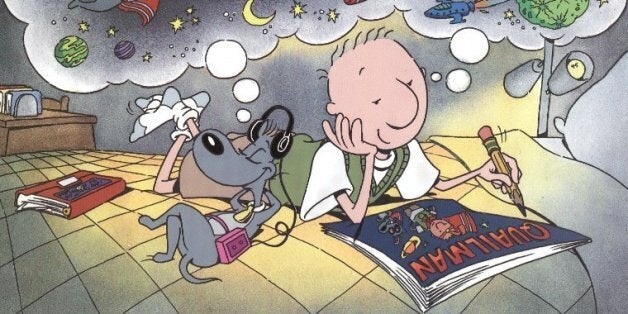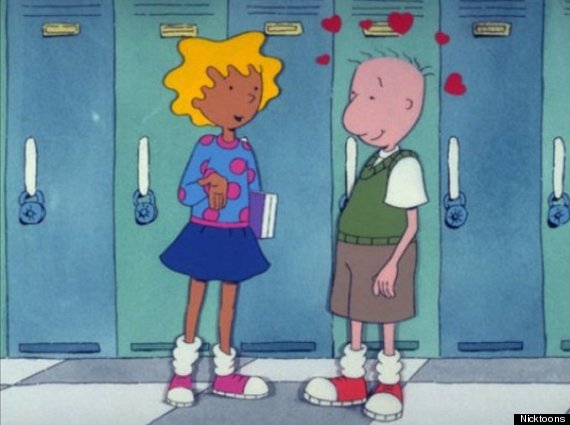
Fifteen years ago today, "Doug" aired its Disney finale. HuffPost TV spoke with creator Jim Jinkins and voice of Doug, Billy West, to discuss the story behind the show that pioneered a new era of kids' TV.
There was nothing like "Doug" prior to 1990. Most of what came before the rise of the new order of Nicktoons -- "Ren And Stimpy" and "Rugrats" -- consisted of pre-approved ideas, taken to the small screen after they had already been widely popularized. That's not to say there wasn't variation, but there was no original content. Shows like "Ninja Turtles" and "Charlie Brown" were taken from comics that came long before their characters found a way to your Saturday morning tube. "Where's Waldo" had already been a hit as a book. The "Doug" pilot, "Doug Bags A Neematoad," was the first in a new era of kids' programming and, perhaps more important, the lessons it taught continue to pervade pop culture more than two decades later.
"It was impossible." Jim Jinkins said, remembering the way his show got picked up. Not only were networks not yet trading in original ideas, but Jinkins hadn't even counted television among his hopes for the character, which started out as something he was doing just to process his day.
Where Doug had a diary, Jinkins had single-panel cartoons. The creation of Doug popped up as an alter ego who just so happened to be easy to draw. "Those are not hair plugs!" Jinkins said, clarifying the identity of the eight lines sticking out of Doug's head. "That was just my way of using the least amount of lines to create this character and this world."
The image of the sparsely-drawn boy may be cemented in our mind, but his name wasn't always Doug. When Jinkins first conceptualized an alter ego, he called him Brian. "I just thought Brian was too fancy of a name," Jinkins said, "So, I geared it down, and started calling him Doug. If you think about what that sounds like, it sounds incredibly average, and that’s what I was trying to do: express from that point of view.”
"I just thought Brian was too fancy of a name, so ... I started calling him Doug."
Once Jinkins realized he was on to something with the cartoons he'd be drawing, he consulted with his friend and eventual business partner, David Campbell, and decided to create a book. Jinkins took a prototype titled "Doug Got A New Pair Of Shoes" to a variety of publishing houses only to face rejection. (He got a bite from Simon & Schuster, but the position changed hands before it could be green lit.)
It took Jinkins five years to take Doug from a doodle to a book over the course of his time in New York. As Jinkins put it, "there were plenty of heartbreaks and set backs." It might seem strange, and though he was working at Nickelodeon at the time, Jinkins didn't use his position to further the idea of "Doug" as a series. He didn't even have the small screen in mind for the character.
As Jinkins remembers it, someone he had told about his work on Doug led his name to Linda Schupack, who had heard Nickelodeon was looking for original ideas. Jinkins was given the number for Nicktoons, where he was eventually sent to pitch "Doug Got A New Pair Of Shoes" to executive Vanessa Coffey.
"She looked at the cover of the book and, in the middle of me describing it, just ran out of the room ... which is, you know, disturbing," Jinkins said. As Coffey would later explain to him, she was running to her boss to tell him that, "This [Jinkins] guy is the real deal, and we're taking him to pilot."
"At the time nobody had the courage to do what Vanessa had the courage to do," Jinkins said. "Doug" had been seen once commercially, in the form of a grapefruit ad, but that was the entirety of his exposure. "Nobody was talking about something with a creator no one had heard of or a show no one had heard of. Everything was a pre-sold idea."
From there, using all New York writers and voice-over people, Jinkins set out to create an eight minute pilot titled "Doug Can't Dance." Once he had procured production costs from Nicktoons, he set up an independent company called Jumbo Pictures, which ensured him full control of "Doug."
As it turned out, Coffey had picked up three total shows for Nicktoons: "Doug," "Rugrats" and "Ren & Stimpy."
Almost immediately, the process behind "Doug" focused on the narrative. "The priority for me was always the story. If we could play the track and laugh and have a solid message, we knew we had a good episode."
And that story always deliberately found its way to a moral center. Jinkins would have his writers specifically identify the kid issue they were addressing a top of each individual script. "It sounds a little self-righteous," Jinkins said, "But I always knew there was going to be a moral foundation to the series."
Often, the writers would argue about the way the system of ethics might pan out in Bluffington. There was a particularly violent debate while constructing the episode in which Doug finds money and returns it to an elderly lady.
"I didn’t want to show all of the ambiguity of the adult world to kids. I wanted to show kids a world where everyone took honesty seriously.'"
"The fight was about how each of us thinks about honesty," Jinkins said, remembering the decision to see Doug rewarded for his act of kindness with a mere stick of gum, "It comes down to how we think about who is involved in a story. In that case, I wanted Doug to do something that hurt where there was no tangible reward."
Throughout the series, honesty ruled supreme, alongside a more subtle message about wanting to be different during a very specific coming-of-age moment. Doug wants to be special, but he is average. He can't do much about the fact that his nose is big or that he's bad at basketball and worse at dancing. He can't make himself be different, but he has an active choice in always working to be a good person.
Ultimately, that kind of purity is what Jinkins wanted to communicate to his audience. "We put ourselves through enormous pain to avoid pain and I had this notion of: 'What if we didn’t do that? What if we just told the truth?" he said. "But that’s complicated. In the adult world, the notion of truth and not-truth is complicated, but I didn’t want to debate it. I didn’t want to show all of the ambiguity of the adult world to kids. I wanted to show kids a world where everyone took honesty seriously."
There's no question that Doug's life closely mirrored that of Jinkins. Patti came from his childhood, as did Roger and Mrs. Wingo, among others. The original pilot, titled "Doug Can't Dance," was inspired by the fact that Jinkins can't dance, as a result of being raised in a household that did not allow dancing, "because of religious reasons that now seem absurd."
Another narrative debate stemmed from an episode in which Doug found himself on the same basketball team as Roger, who was intent to tease him about his lack of appropriate footwear. A Nicktoons story editor came in and disagreed that Roger and Doug would ever be on the same team given their opposition. The bullpen of writers set to arguing about how the scene should play, until Jinkins blurted out, "But that's how it really happened!"
As Jinkins said, "Moments like that just brought everybody back around to the realization that this was a person's story." Yet, Jinkins recognizes that while Doug functioned as an alter ego, he also held a place as the everyman (or every-pre-teen), and all of the folks involved in "Doug" brought a little of themselves to that concept.
Jinkins recalled the audition process for the voice of Doug, a part that eventually went to Billy West. Jinkins didn't think that West was a good fit, but Coffey knew he was right for the part. “She understood something about Doug that hadn’t even come to me yet," Jinkins admitted, recalling how well the pilot tested.
West, who also came to voice both Ren and Stimpy, always felt there was something special about Doug, and ended up sharing much more than a voice with the titular character.
“There’s a lot of me in there, because I’m going through my own experiences in there, because I have a conscience," West said. "That’s something that is missing in a lot of people these days ... but Doug was a very pure character, and I connected with that. You know, kids that watched Doug learned that he would be forgiving of someone that wronged him in any way. He’d also be apologetic, when he learned that he had done something that was not the greatest thing in the world to do. There was accountability."
West and Jinkins worked well together through the first years of the series, between 1991 and 1994, but their relationship came to blows when "Doug" transferred from Nickelodeon to Disney. "The switch made up some of the most painful evolutions I've ever had to go through," Jinkins said.
"I got my nose out of joint, because I felt like I was the center of it. But really, no one person could be the center of that show.'"
Jinkins was beyond frustrated. He had a team that knew his show backwards and forwards, and changing things up while things were catching steam felt like an absurd obstacle to all he'd built. At the same time, he recognizes that the shift allowed "Doug" to go through a process of rebirth.
"For all the kids who complain about what Disney did with 'Doug,' almost every one of those changes came from me," Jinkins said. The major thing he regrets was not being able to take West with them, but moving Doug up to age 12 and a half allowed him to have a slightly deeper voice when they swapped actors and started using Tom McQue.
"It was a deal that I just couldn’t take," West said of the switch, "No one was taking me seriously, and they kept sending me deal memos. And they kept saying, 'Time is running out!' And I kept saying, 'I don’t care.'"
Jinkins emphasized that he fought to keep West, and all these years later, remains worried West does not know how hard he tried. “We have 180 degree different storytelling about this, but I was there and he was not," Jinkins said, "He’s been told what his agents tell him ... The deal was just breaking the back of our budget, and Billy just doesn’t know that."
Beyond the economic issues, Jinkins was unhappy with the way West's representation characterized his role in the show. “I’ve always felt like as much as his agents were describing him as the center of the 'Doug' series," he said, "I got my nose out of joint, because I felt like I was the center of it. But really, no one person could be the center of that show.”
Looking back at "Doug," Jinkins has come to terms with the way people read things into the characters. He's been asked about the whole color issue, of course, and encountered the question of whether Skeeter was black (even once entertaining a call from a man writing a dissertation on race in cartoons).
"If that's how you see him, that's great. It's not a bad thing, but I never planned it. Skeeter is blue and he's Doug's friend.'"
"There have been a few people that have tried to get at this idea that the lead -- the guy that’s really important -- is white," Jinkins said, "I’ll be happy to go back and make him yellow, or purple, or magenta, if that works. Or some other color ... People are certain that Skeeter is an African-American guy. ‘I’m like, well, he’s blue!’ You put together that he's the music guy and he does some rap stuff or several other things, great. If that's how you see him, that's great. It's not a bad thing, but I never planned it. Skeeter is blue and he's Doug's friend."
As Jinkins sees it, the array of colors came to symbolize the irrelevance of race. He noted that Roger is green, but so is Doug's beloved teacher Ms. Wingo. Once he removed the overlay of what color people are, he used it to refute that prejudice that could come with the idea of green being associated with “the bad guys."
Although, the color choice started out much more simply than any pointed take-down of race might have. When Jinkins set out to add color to the world of Bluffington, he realized he had so many more options than just the basic flesh tones. “Now it’s time to color in the people, so you grab your eight shades of skin, you put them in your hand and start," he said. "But then I looked back up at my full set of 200 design markers and thought, 'I’m making this up. I can do what I want to do, why stop here.'"
And as for why Doug ended up white? "I think Doug probably got color on him quicker," Jinkins said, "I hadn’t thought through these opportunities and what not ... Patti is a little more thoughtful, I wanted her to have dark skin, so I picked a flesh-range color, and that can be a great tan or ethnicity, but it all just started out as an experiment in how that could go."

There's no question that "Doug" had Jinkins' desired effect. West remembered an early '90s visit to a bed and breakfast, during which he woke up to find a bunch of kids watching the show. “My heart was warmed and I sat there and I watched it with them and I can’t remember if I let everybody in on it," West said. "I just wanted to watch their reaction and see if it had the effect I thought it would have.” (It did.)
"In the end, that's the way life is. It's bittersweet and it doesn't always work out the way you dreamed.'"
More than two decades after its premiere and 15 years after the finale, Doug's impact is visible not in just the nostalgia longings of millennials, but the way it has dotted pop culture. We can look to later kids' shows, like "Arthur," which took its structure almost directly from "Doug" (and hired several key people who worked on "Doug") or the evolution of thoughtful pre-teen and adolescence-focused shows that came after it (like "Malcom In The Middle," which had a similar crossover). It's even arguable that that influence of decent morality can be seen in today's pop stars: "Twenty years ago," The Atlantic wrote on the 20th anniversary of Nicktoons, "Doug was coming to terms with being 'Born This Way'."
Jinkins wasn't done when he thought he'd lost Doug at Nickelodeon, and he's still not done now. "I've still got one more story left in me," he said, "And I can't wait to think it up."
A few weeks ago, started mulling over an idea for what he would call "Doug's Last Movie" (a compliment to "Doug's 1st Movie, which came out in 1999).
When that comes to be, it will focus on the way we process our childhood friendships, and what they mean to us even after they've come to an end. "That would be the final message to fans," he said. "These relationships change us and they shape us, but they don't last forever."
Asked what ever happened to Doug and Patti, Jinkins hesitated to provide a solid answer. “Who do you know in the world who meets somebody at 11 and ends up marrying that person?” he asked.
"In the end, that's the way life is," he said, growing quiet, as he reflected on bringing "Doug" to a concrete end. "It’s bittersweet. It doesn’t always work out the way you dreamed."
